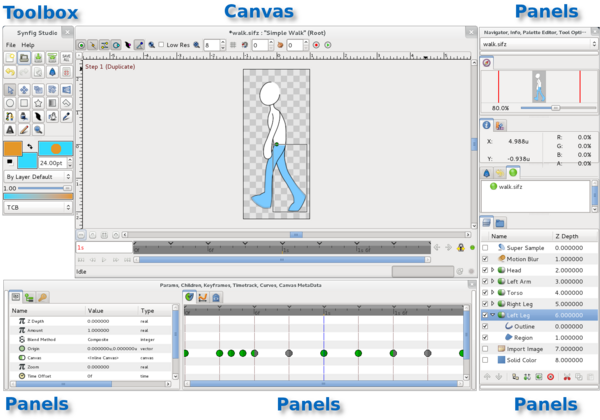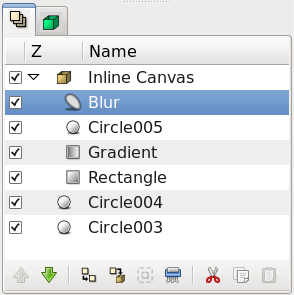Vasta-alkajille
| Language: |
English • čeština • Deutsch • español • suomi • français • italiano • 日本語 • Nederlands • polski • português • română • русский • 中文(中国大陆) • 中文(台灣) |
|
Warning! This page contains outdated information. The release of Synfig Studio 0.64.0 introduced new terminology and this translated page needs to be updated according to original English text. You can help updating this page - see instructions here. Thank you! |
Contents
Käyttöliittymä
Kun käynnistät Synfig-studion, avautuu näyttöön alla olevassa kuvassa näkyvät ikkunat.
Synfig-studion käyttöliittymän tärkeimmät osat ovat:
- Työkalupakki — on Synfig-studion pääikkuna. Siihen kuuluvat järjestelmävalikko, painikkeita, työkaluja ja muuta tarpeellista, joilla voit luoda ja muokata animaatioita. Tämän ikkunan sulkeminen lopettaa ohjelman.
- Kangas — tekemäsi grafiikka ja animaatio ilmestyy tänne.
- Paneeleissa — on työkaluja ja tietoja projektisi tietyistä osista. Joittenkin paneeleitten kautta voit jopa muokata näitä osia.
|
Huomio Jos Synfig-studion käyttöliittymä on sinulla erilainen, voit palauttaa sen kuvassa näkyvään vakiokokoonpanoon. Valitse Työkalupakin "Tiedosto"-valikosta "Paneelit → Palauta ikkunat vakiokokoonpanoon".
|
Keskellä olevaa ikkunaa kutsutaan Kangasikkunaksi. Aina, kun käynnistät Synfig-studion, se avaa uuden Kangasikkunan. Se ilmentää juurikangasta, mikä ei ehkä sano sinulle mitään, mutta se ei haittaa — meneillään on vasta tutustumiskierros. Kangasikkunan vasemmassa yläkulmassa näkyy painike, jossa on väkänen. Jos napsautat väkäpainiketta, putkahtaa esiin kangasikkunavalikko. Sama valikko tulee näkyviin, jos kangas-alueella hiiren alla ei ole tasoa ja napsautat oikeaa nappia. Nyt siis tiedät missä kaikkein tärkein kangasvalikko on. Hyvä.
Kaksi muuta ikkunaa (toinen alhaalla, toinen oikealla) o vat mukautettavia telakkaikkunoita. Kussakin telakassa on joukko paneeleita, jotka on järjestetty joko vaaka- tai pystysuuntaisesti. Jotkut paneelit jakavat saman tilan telakan sisällä, ja voit vaihdella niiden välillä napsauttamalla niiden välilehtien korvakkeita. Voit järjestää telakan sisällön makusi mukaan raahaamalla välilehtiä korvakkeesta haluamaasi paikkaan. Voit jopa tehdä uuden telakkaikkunan raahaamalla paneelin ulos entisestä telakasta.
Vaikka sattuisit vahingossa sulkemaan paneelin (raahaamalla sen ulos telakasta ja sulkemalla uuden ikkunan), ei ole syytä huoleen. Saat sen takaisin Työkalupakista, kun valitset sen valikosta "Tiedosto → Paneelit" ja napsautat kyseisen paneelin nimeä.
Tärkeimmät paneelit ovat:
- Tasopaneeli — näyttää työstämälläsi kankaalla olevien tasojen hierarkian. Sen kautta voit myös käsitellä tasoja eri tavoin.
- Ominaisuuspaneeli — näyttää valitun tason ominaisuudet. Jos valittuna on useita tasoja, näytetään vain ne ominaisuudet, jotka ovat niillä kaikilla.
- Työkalusäätöpaneeli — näyttää käytössä olevaa työkalua koskevat säädöt, mikäli sillä niitä on.
- Kartta — näyttää valitun kankaan pienoiskuvan, jota voi lähentää ja loitontaa (zoomata) ja josta voi siirtyä eri puolille kangasta.
- Historiapaneeli — näyttää teokseen tehdyt toimenpiteet luettelona. Historiasta voit myös muokata tapahtumia.
Näiden lisäksi Synfig-studiossa on monia muita paneeleita. Mikäli sinulla ei ole harmainta aavistusta mitä jokin paneeli tekee, pidä hiirtä sen kuvakkeen päällä, niin esiin ponnahtaa työkaluvihje, joka selittää paneelin toimintaa.
Konepellin alla
Synfig-studio, kuten useimmat muutkin pätevät grafiikkaohjelmat, jakaa kankaalla olevat yksittäiset elementit tasoiksi. Se eroaa kuitenkin muista ohjelmista kahdella merkittävällä tavalla:
- Yksittäinen taso Synfigissä esittää yleensä yhtä "alkeisoliota", kuten yhtä aluetta, alueen ääriviivaa, tuotua kuvaa, jne. Tämä antaa sinulle runsaasti jouston varaa ja vaikutusmahdollisuuksia. Ei ole mitenkään tavatonta, että teoksessa on satoja tasoja (taiteilijan mielenterveyden takaamiseksi tietysti hierarkisesti järjestettynä).
- Tasoja ei käytetä pelkästään lisäämään informaatiota alla olevan kuvan päälle, vaan niillä voi myös muovata tai vääristää sitä eri tavoin. Tässä mielessä Synfigin tasot toimivat pitkälti Adobe Photoshopin tai GIMPin suodattimien tapaan. Esimerkkeinä mainittakoon Sumennustaso, Säteissumennustaso, Palloistustaso, Värikorjaustaso ja Viistetaso.
Kaikilla tasoilla on joukko parametreja, jotka säätelevät sen käyttäytymistä. Kun napsautat tasoa (joko Kangasikkunassa tai viereisen kuvan Tasopaneelissa), sen säädöt näytetään Ominaisuuspaneelissa. Each layer has a set of parameters which determine how it behaves. When you click on a layer (either in the Canvas Window, or in the illustrated Layers Panel), you will see its parameters in the Params Panel.
Ensiaskeleet
Tehdäänpä jotain kivaa, että päästään näpräämään ohjelmaa!
Mene ensin työkalupakkiin ja näppää ympyrätyökalua. (Jos et tiedä mikä se niistä on, pidä vain hiirtä paikallaan nappuloiden päällä, kunnes esiin putkahtaa vihjeteksti "Ympyrätyökalu".)
Kun napsautat ympyrätyökalua, pane merkille, että Työkalusäätöpaneeli muuttuu. Mutta palataan siihen myöhemmin.
Nyt kun ympyrätyökalu on valittu, voit piirtää ympyröitä kangasikkunaan. Se toimii odotetusti — näppää kankaalle, muuta säteen pituutta raahaamalla ja päästä hiiren nappi, kun olet valmis. Kokeile itse, ja piirrä pari ympyrää (tai enemmän, jos siltä tuntuu). Jos päästät hiiren napin vahingossa ennen raahaamista, on tuloksena nollasäteinen ympyrä, joka on käytännössä näkymätön! Ei syytä huoleen, se on helppo korjata.
With the Circle Tool selected, you can now create circles in the Canvas Window. This works as you might expect — click on the canvas, drag to change length of the radius, and release the mouse button when you are done. Go ahead and create two circles (or more, if you fancy). If you accidentally release the mouse button before dragging, you end up creating a circle with 0 radius and it is effectively invisible! No need to worry, you can easily fix this. In the Params Panel, you can change the parameters of the selected object. If you just made a 0 radius circle, it should be the current selected object. You can change its radius to some value other than 0, say 10, and manipulate it to your liking with the canvas ducks later.
|
Note Some users might experience the following problem: when you click and drag on the canvas using the Circle Tool, either nothing seems to happen or you end up making insanely huge circles. To fix this go to "File → Input Devices" and disable all the devices you can find there. If you have an extended input device that you want to use, such as a pressure-sensitive pen, then enable it in this screen. After this change Synfig will work as expected.
|
Now go back to the toolbox and click on the Muuntotyökalu (the blue circle with the arrow on it). After you do this, click on one of your circles. You will see a bounding box (which is kind of useless at this point in time, but I digress), a green dot at the center, and a cyan dot on the radius. Those dots are called "ducks". If you want to modify the circle, grab a duck and drag it around. Easy!
You can select a Layer by clicking on it. If you want to select more than one layer, hold down Ctrl key while you are clicking — this works in both the Canvas Window and the Layers Panel. Try it!
You can also select multiple ducks. You can do this in several ways. First, you can hold down Ctrl and individually click the ducks that you want selected, but this can be tedious. However, there is a much faster method — just create a selection box by clicking the mouse and dragging it over the area of ducks that you want selected.
Go ahead, select two circles and select all of their ducks. With several ducks selected, moving one duck will move all of the ducks.
|
Note Synfig Studio has an autorecovery feature. If it crashes, even if the current file has not been saved, you will not lose more than 5 minutes of work. At restart it will automatically prompt to recover the unsaved changes. Unfortunately history isn't recovered yet.
|
The rotate and scale tools work much like the Transform Tool, except in the case where you have multiple ducks selected. It is much easier just to try, than read about it. Select a few circles, select all of their ducks, and try using the rotate and scale tools.
Note that duck manipulation tools have options associated with them. If a particular tool isn't doing what you want, take a look in the Tool Options Panel to see if it is set up the way you want.
You may find that Synfig Studio is SLOW, making it practically unusable on the old hardware. The biggest reason for this is that all of the color calculations are done in floating point — to enable High-Dynamic-Range Imaging.
However, some major re-implementations and optimizations are planned to be made that should quite dramatically improve the performance of Synfig on all platforms. The goal is not a 200% speed increase, but at least a 2000% speed increase. Currently there is a work in progress in development branch implementing those optimization via OpenGL. It already shows very promising results, but is not ready for usage yet.
Linking
Now let's try linking. Suppose we always want these two circles to be the same size. Select two circles, and then select both of their radius ducks (the cyan dots).
To select multiple ducks, either drag a rectangle around them, or select the first one, then hold the Ctrl key while selecting the rest. Once you have the two radius ducks selected, right click on either duck and a menu will pop up. Select "Link". Boom. The parameters are linked together. You can prove it to yourself by selecting just one of the circles and changing its radius — the other one will change as well. Neat stuff, eh? This is how outlines are attached to their regions — but I'm getting ahead of myself.
Linking is a fundamental concept in Synfig. You can create links not only between ducks, but also between parameters as well by selecting multiple layers, right clicking on the parameter in the Params panel, and selecting "Link".
Color selection
Let's say you want one of the circles to be a different color. If you look in the toolbox below the tools, you'll see the outline/fill color selector, the outline width selector, and some other stuff like the default blend method and gradient. The outline/fill color widget works exactly as you might expect — you can click on the fill color, and a modest color chooser will appear. Now you can change the color pretty easily.
But sometimes you just want to click on a color and go. This is where the palette editor tab comes in.
Its functionality isn't quite 100% yet (saving and loading custom palettes is not implemented), but the default palette is pretty decent.
Click on the Palette Editor panel tab and have a look — it's the one with the palette-ish looking icon. Clicking on colors with the left mouse button will immediately change the default outline color and clicking with the middle mouse button will change fill color.
That's all great, but we still haven't changed the color of the circle. There are three ways to do this. The first is to click on the "Fill Tool" from the toolbox, and then click on the circle in the Canvas Window. Boom. Circle changes color. This works with more than just circles. Also, you can select the circle layer you want to modify, go to the Params panel, right-click on the Color parameter and select "Apply Fill Color" or "Apply Outline Color" at you preference. Or simply double-click on the "Color" parameter - a color selector dialog will show up, and you can just tweak away.
Try playing around with the circles for a bit. Muck around with the parameters, and see what happens. To get you started, try out to set the Feather Parameter to 5.
Digging deeper
Of course, so far you just found out how to use the basic features of Synfig Studio but not how you animate a drawing. This is covered in the next section.

